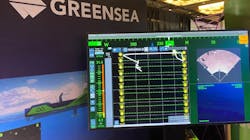By Eman Abu-Khaled, Assistant Editor
New exhibitor Greensea Systems Inc. showcased its new Opensea Edge technology for the oil and gas industry at the recent Subsea Tieback event.
Offshore chatted with David Pearson, program manager with Greensea, to better understand the idea behind the combination of the OPENSEA software and the edge hardware.
“OPENSEA Edge provides a platform of autonomy and AI/machine learning that is mounted physically to the vehicle,” he explained. “It's a bit like adding a brain to the body of a robot.”
Data containing processed imagery from the forward-looking sonar and camera imagery of subsea objects from a camera on board is sent back to operators to look over and assess.
The company said OPENSEA Edge also addresses the need for a more cost-efficient and environmentally friendly approach to the oil and gas industry in offshore and subsea settings.
Remote robotic operations cut out the need for costly deployment of large vessels and crews for general maintenance of offshore tasks.
Dillon Grady, Greensea’s director of sales, told Offshore this technology can be trained to do common subsea inspection tasks for monitoring change detection or corrosion in a subsea asset and communicate this back to the operator monitoring the ROV.
“We have taken a vehicle agnostic approach by building the entire software stack into a module and moving it out onto the platform to give ROV operators in the offshore energy market a powerful solution to bring future field capabilities to the systems that are operating today,” he said.
Case study
This type of technology addresses a problem the US Navy was experiencing when encountering possible subsea mine locations. Combining the OPENSEA software and the edge model for the hardware, the company said it is now easier and more efficient to identify mines and note their locations in areas oftentimes requiring a whole crew and ship venture.
“The development of these technologies for use in the defense industry are motivated by keeping people safe and having robots do the dirty work of hunting for explosive ordnances,” Grady said. “The commercial use of OPENSEA Edge would be that the vehicle could be trained to identify objects of interest and then report back to the person in the loop, ‘Hey, I think I found something. What should I do?’”
He goes on to explain that by putting these different target recognition libraries into the machine learning, the vehicle can adapt to its surroundings and then act on a mission. Vehicles outfitted with acoustic modems and batteries could be operated tetherless, and adding standard communication relay devices (cellular modems, radios or satellite) allows operators to be located much farther away.
About the author: Eman Abu-Khaled is a recent graduate from Kent State University and one of Endeavor Business Media’s 2023 Pathway Program trainees. The Endeavor Pathway Program is designed to chart a course for entry-level candidates who are interested in pursuing careers in sales, marketing and journalism professions. This is a paid four-month training program that prepares young professionals for a permanent position.






